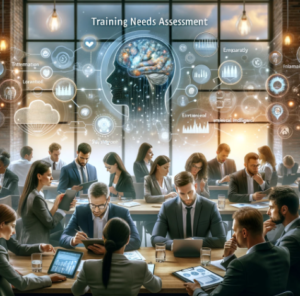
In today’s dynamic business landscape, organizations must constantly evolve to stay competitive. Training and development play a pivotal role in equipping employees with the skills they need to thrive. However, conducting a thorough training needs assessment is crucial before designing any training program. By integrating emotional intelligence (EQ) into the training needs assessment process, organizations can identify the specific developmental areas that will have the greatest impact. In this blog post, we will explore the importance of training needs assessment and how you can leverage emotional intelligence as a powerful solution to address those needs effectively.
What is a Training Needs Assessment?
Training needs assessment is the systematic process of identifying gaps in knowledge, skills, and competencies within an organization. It helps determine the training requirements necessary to bridge those gaps and enhance individual and organizational performance. A well-executed training needs assessment ensures that training programs are targeted, relevant, and aligned with strategic goals.
What is the Role of Emotional Intelligence in This Type of Assessment?
Emotional intelligence plays a pivotal role in conducting an effective training needs assessment. Let’s explore how emotional intelligence can enhance the process:
-
- Empathetic Data Collection:
Emotional intelligence enables trainers and assessors to gather data with empathy and sensitivity. By actively listening, observing non-verbal cues, and creating a safe and inclusive environment, trainers can encourage employees to share their challenges and aspirations more openly. This empathetic data collection ensures a comprehensive understanding of the training needs, fostering trust and engagement.
- Identifying Performance Skills Gaps:
Emotional intelligence encompasses essential performance skills such as self-awareness, empathy, and communication. These skills (traditionally known as “soft” skills) are crucial for effective teamwork, leadership, and collaboration. Emotional intelligence helps trainers identify gaps in these areas, which are often overlooked in traditional training needs assessments. By recognizing the importance of performance skills, organizations can design training programs that cultivate emotional intelligence competencies.
- Uncovering Individual Needs:
Emotional intelligence allows trainers to understand the unique needs of individuals within the organization. Each employee has different learning styles, preferences, and aspirations. Emotional intelligence enables trainers to uncover these individual needs and tailor training programs accordingly. By personalizing the learning experience, organizations can maximize engagement and knowledge retention.
- Evaluating Organizational Culture:
Emotional intelligence helps assessors evaluate the organizational culture and climate. By examining emotional dynamics, interpersonal relationships, and communication patterns, trainers can identify cultural barriers that may impact the effectiveness of Learning & Development programs. Emotional intelligence enables organizations to address cultural challenges through targeted training interventions.
- Empathetic Data Collection:
How do I Conduct an Emotional Intelligence-Infused Training Needs Assessment?
To conduct a training needs assessment with emotional intelligence, follow these steps:
- Define Organizational Goals:
Clearly articulate the organizational goals and strategic objectives. This will provide a foundation for aligning the training needs assessment process with the overall business objectives.
- Establish Assessment Criteria:
Identify the specific skills, knowledge, and competencies required to achieve the organizational goals. Consider both technical and performance skills, including emotional intelligence competencies such as self-awareness, social awareness, relationship management, and self-regulation.
- Gather Data:
Utilize a variety of data collection methods to gather comprehensive information. Conduct surveys, interviews, focus groups, and observation exercises to capture both quantitative and qualitative data. Apply emotional intelligence principles during data collection to ensure empathy, active listening, and a safe space for employees to express their needs.
- Analyze and Prioritize Training Needs:
Analyze the collected data to identify common themes, trends, and areas of improvement. Prioritize the training needs based on the impact they have on the organizational goals.
By Josh Rosenthal, Director of Training for TalentSmartEQ. For more information, please check out additional resources at: www.talentsmarteq.com.
These strategies were adapted from the new book, “Emotional Intelligence Habits” by Dr. Travis Bradberry. To order, click here. For more strategies that can help you improve engagement at your organization, check out our training programs or contact us.